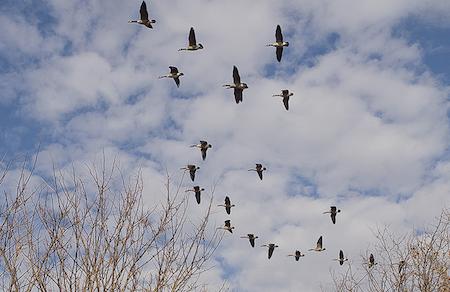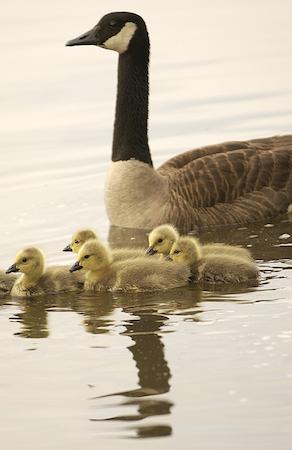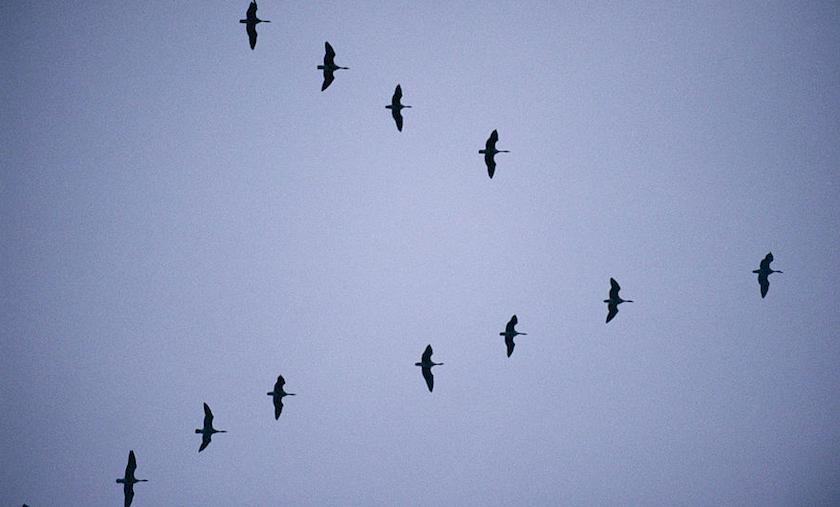For more than a decade, groups working to restore wetlands on the Anacostia River have been exasperated by a feathery foe: Canada geese that never leave.
These “resident” geese, a subspecies of the migratory population that visits the Chesapeake Bay region each winter, were introduced half a century ago for sport hunting. But they’ve become a little too comfortable in the suburban and urban parks where they find food aplenty and few predators.

Canada geese fly over the Anacostia River near the National Arboretum in 2012. (Dave Harp)
Earlier this year, more than 500 of them had taken up residence in and around the nearly 2-square-mile Anacostia Park, which is run by the National Park Service. There, with easy access to the river, the waterfowl could snack on wild rice and other submerged aquatic vegetation that groups like the Anacostia Watershed Society have been planting in an attempt to restore tidal wetlands.
An estimated 2,500 acres of tidal wetlands flanked the Anacostia River before the U.S. Army Corps of Engineers channelized the river with stone banks in the early 1900s. Industry and lots of people moved onto the landscape that once filtered water and provided wildlife habitat, adding to the Anacostia’s pollution woes. In the 1980s, the Park Service began working with other groups to restore nearly 100 acres of tidal marshes by planting vegetation along the banks — but their seeds have struggled to take root.
“The [geese] eat them the second the poor little plant pops out of the ground,” says Jim Foster, president of the watershed group. “We’re working to restore the wetlands, and the geese are picking it off as soon as it gets started.”
But, under a new management plan the Park Service approved this summer, there will be significantly fewer geese on the river year-round to threaten the restoration effort — at least for now. The Park Service announced its plan at the end of June to manage the wetland restoration by better “managing” the geese. The last paragraph of their press release describes the service’s decision to reduce the resident geese population “through lethal control (capture and euthanasia) and reproductive control (egg oiling).”
Soon after the plan was announced, 365 geese were removed from the park and euthanized, says Jenny Anzelmo-Sarles, a Park Service spokeswoman. While the practice of killing geese and other overabundant species is not uncommon in managed areas across the country, this was the first time the Park Service had resorted to culling geese in the Washington, DC, area.
“We think there’s a (wetland) seed bank that could regenerate itself as we take away pressure from these geese,” Anzelmo-Sarles says, explaining why the geese were removed. “They are some of the last remaining wetlands in the District and really important to creating a healthy and ecologically diverse wetland system for the Anacostia.”
Resident flocks of Canada geese have established themselves at city parks, golf courses and in neighborhoods throughout the Chesapeake Bay region. Research by the U.S. Geological Survey in 2007 showed that their numbers had expanded to about one million resident birds in the Atlantic Flyway, where they are presenting a growing number of ecological problems.

Canada geese raise four to eight goslings a year. (Dave Harp)
The USGS study said resident geese were contributing to a “major decline” of wild rice in tidal marshes of the Patuxent River, where the aquatic vegetation would otherwise feed a variety of migrating wetland birds while improving water quality. One year after removing many of the geese in the Patuxent marshes, the USGS found that, the vegetation showed a statistically significant rebound.
Hunting in more rural areas, where it is permitted, can often keep the birds’ numbers in check. But that wasn’t an option in the Anacostia’s urban watershed.
The Park Service worked with the U.S. Department of Agriculture’s Wildlife Services program to remove and euthanize the geese this summer, a measure that could be repeated for a few years, depending on how the wetlands fare. A spokeswoman for the program, Pam Boehland, says the big birds were herded into nets at a time when they were shedding feathers and could not easily fly. They were trucked away and poisoned by filling their crates with carbon dioxide gas, a method which Boehland says is in accordance with the American Veterinary Medical Association guidelines for euthanizing animals.
Breast meat from the geese was tested for safety, then donated to the nonprofit DC Central Kitchen to help feed the city’s needy.
“We do goose roundups throughout the East Coast,” says Boehland, citing needs around airports or playgrounds where they become hazards for aircraft and children. “It’s usually an integrated approach that includes harassing the birds to discourage them from being in certain places and, when necessary, euthanizing.”
The management plan for the Anacostia also includes continuing an ongoing effort to coat geese eggs with oil when they are laid in the spring. This prevents them from hatching, and prevents the birds from just laying new eggs — which they will do if the first clutch was taken or destroyed.
The Park Service’s new plan also calls for uprooting invasive plants so that native ones can thrive, and establishing more “no wake” zones near key wetland habitats in the Anacostia, where fast-moving boats can contribute to erosion. The Park Service, which owns the riverbed and much of the land surrounding the river, will be working with other groups to monitor the ongoing health of the wetlands.
Foster says his group has in the past deployed 4-foot-high posts with 30 feet of netting around them to protect wild rice shoots from the geese. Since the Park Service took action, the group of 200 geese that typically congregates near Watts Branch is “a lot thinner.”
The Park Service plan calls for initially removing more than half of the resident geese near the Anacostia, which officials did this summer, but ongoing measures will be based on the health of the wetlands, Anzelmo-Sarles says. The plan states that lethal control, including shooting mature or self-sufficient young-of-the-year resident geese, can be used to remove up to 90 percent of the resident population if the park’s wetland goals are not reached.
“It’s not about the geese themselves but about how they affect the wetlands,” she says. “We will monitor vegetation and work to continue to reduce the population so the wetlands can be healthy.”
The Park Service contracts with sharpshooters to kill deer in the District’s Rock Creek Park, where they have become so numerous they’re impacting the vegetation and posing hazards for motorists. Their meat is also donated to local organizations.
So far, killing geese hasn’t seemed to stir the same controversy that’s attended culling populations of other wildlife deemed an ecological problem. John Griffin, director of urban wildlife for the Humane Society of the United States, says that’s in part because the public “usually has no idea” when these plans are passed and the birds quickly killed. His organization represented two others in its opposition to the plan, which he says neither justified the need for lethal action nor fully explored other alternatives.
“Just because it’s easy doesn’t mean it’s ethical. If you’re going to kill animals, then you need to justify it,” Griffin says. “To say, ‘we just want to remove this one species that’s causing a problem,’ that sets a troubling precedence.”
There was plenty of pushback from animal lovers in 2003, when the Maryland Department of Natural Resources first announced its plan to shoot 1,500 mute swans, almost half of the state’s population of the nonnative bird, to protect underwater grass beds and native species.
In contrast, Bay residents are now close to celebrating the near eradication of the invasive nutria, a rat-tailed South American muskrat that was chewing its way through Eastern Shore marshes until officials started trapping them. On the Anacostia, Foster says that for the last decade, expensive wetland restoration projects have entailed planting the seeds and then “getting the geese to leave it alone so they can grow.” They’ve tried to shoo the birds away and put cages over new plants to prevent geese from grazing — but they can’t fence off all of the river’s wetlands.
He’s looking forward to at least part of that effort being easier.
Whitney Pipkin writes at the intersection of food, agriculture and the environment from her home base in Northern Virginia. Her work for the Bay Journal often focuses on the Potomac and Anacostia rivers, and she is a fellow of the Institute for Journalism & Natural Resources.



Write a Letter to the Editor on this Article
We encourage readers to offer their point of view on this article by submitting the following form. Editing is sometimes necessary and is done at the discretion of the editorial staff.